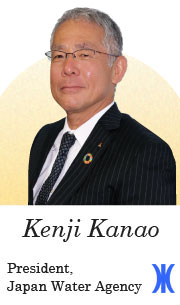New Year’s Message from the president

A happy new year. I wish all of you a very good year.
Last year, the new coronavirus infection spread all over the world and had a great impact on society. To cope with this situation, the Japan Water Agency initiated a new work system such as working from home by group formed at our offices and implementation of web meetings, etc. as ways of minimizing close contact among our staff members as well as our associates and customers and executed the work appropriately.
As the role of water remains important during the “with corona” days, we will continue to take thorough infection prevention measures and strive for a stable supply of water.
In recent years, due to the effects of climate change, the largest floods in history have been recorded in various places, causing enormous damage. A historic flood struck the Kuma River in Kumamoto Prefecture in July 2020, causing unprecedented damage that killed 50 people. This catastrophe drew attention on the effectiveness of flood control by dams over future flood control measures. As a result, strengthening of the flood control function of the dam has been implemented nationwide by pre-discharge* even including such operation at the water utilization dams. Makio Dam in the Kiso River system, for example, worked very effectively at the time of a heavy rain in July last year. The dams of the Japan Water Agency, including the above, worked on pre-discharge. As pre-discharge operation utilizes the amount of water originally designed for water utilization, it requires the cooperation, or. the acceptance of water users, so that we will continue to strive to gain the understanding of water users.
Nowadays, as there are increasing number of floods that exceed the planned scale frequently, advanced operations such as special disaster prevention operations* and pre-discharges are required for dam management. Precise precipitation prediction is required for accurate dam operation. The Japan Water Agency in collaboration with Kyoto University and the Japan Meteorological Association, participated in the project named “Strengthening of national resilience for disaster prevention and disaster mitigation”, which was the target project on the Phase 2 of the research and development plan, and are now engaged in the development of “Integrated dam disaster prevention assistance system”, which is part of the Cabinet Office's SIP (Strategic Innovation Creation Program). In line with this, we are working for the advancement of pre-discharge of dams using long-term ensemble rainfall forecast information. When this is put into practice, forecasts will be presented with a time margin of 15 days ahead within the range of upper, middle, and lower level of rainfall, including various patterns, so in the event of an abnormal flood. It can be useful for avoidance of extraordinary disaster prevention operations* and earlier determination of the need for pre-discharge. We are aiming for the operation start at each dam during the flood season this year.

Photo-1 Celebrating 400km³ concrete placement
Last year, we earned SDGs bond certification for the issuance of water resources bonds. We will raise funds by issuing bonds to carry out the business. This certification brought us the confidence in ourselves that the various projects we are engaged in are now recognized in contributing to our society in terms of SDGs achievement. In addition, the evaluation of our business in FY2019 was recognized as "being better and exceeded the targets as a whole in the medium-term plan." And as a result we received an A rating. This high evaluation, we believe, resulted from our various performances, including 1) fine-tuned water intake and distribution operations in the Chikugo and Toyo river systems and 2) drought control measures that make full use of consensus building know-how, 3) the appropriate flood control operation conducted at Shimokubo Dam in the Tone River system and the Kusaki Dam in the Tone River system against the largest flood in the history of heavy rainfall in eastern Japan, and 4) Water supply support activities during droughts. The high evaluation was also value-added by various other organizations which were also engaged in such support activities.
In order to adequately respond to the evaluation of the Japan Water Agency from society and fulfill its mission to "supply safe and quality water in a stable and secured manner," the Japan Water Agency will continue performing management and construction of water resources development facilities in full force. We would like to ask for your continued support and cooperation.
January 2021
*pre-discharge: When flood is anticipated under the predicted rainfall amount information and others, water storage level is lowered temporally in advance, discharging stored water out of the water utilization capacity portion.
*special disaster prevention operation: Advanced operations that effectively utilize water utilization capacity in a way that is different from normal operation rules in order to mitigate damage downstream
*extraordinary flood disaster prevention operations:
Operation to gradually increase the discharge rate and eventually discharge the same flow rate as the inflow rate when there is a possibility that the flood control capacity of the dam will be used up due to a large flood.

 Sitemap
Sitemap